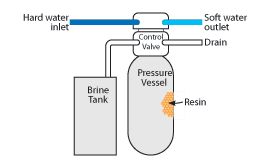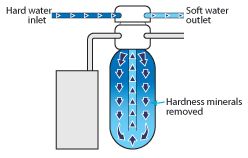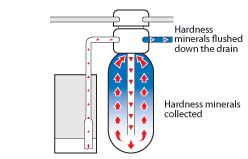How does a Water Softener work?
Softeners have been used since the early 1900‘s to prevent scale in boilers, so the technology is well understood and their performance is predictable and reliable.
They involve a process called ion exchange which uses an ion exchange resin. The resin comprises tiny polymeric beads which are specially formulated so that they can be charged with certain ions. Calcium and magnesium, the causes of scale and scum from hard water, are referred to as ions, and as water passes through the resin the calcium and magnesium ions swap places with the sodium ions on the resin. Sodium salts, unlike calcium and magnesium, are highly soluble so sodium does not cause scale or scum. When all the sodium ions have been exchanged for calcium or magnesium, the resin must be regenerated by recharging it with sodium ions. This is done by flushing the resin with salt solution (brine).
Softeners are supplied in different shapes and sizes. All have a tank to hold the resin through which the water is passed to soften it, all have a tank to store and dissolve the salt for the regenerating brine and all softeners regenerate automatically. There are various ways in which softeners determine when to regenerate - some are fitted with a timer and some regenerate after a pre-set volume of water has been treated.
Ion exchange involves the use of a resin bed. Ion exchange resin is a very small synthetic bead-like material that looks a little bit like brown sugar. The beads are very small, about the size of a pin head.
The process is called Ion exchange because the ions calcium (Ca) and magnesium (Mg) are exchanged for small amounts of sodium (Na).
Water softeners use ion exchange (see above) and although they all differ in design they do share the following characteristics.
 Setup
SetupIn this diagram note the brine tank containing salt, the pressure vessel containing resin and the control valve.
You will also see the inlet, outlet and drain. The overflow is not shown.
 Service cycle (when itís giving you softened water)
Service cycle (when itís giving you softened water)During the service cycle, hard water enters the control valve where it is sent down through the resin bed where the hardness minerals are removed.
The soft water then travels up through a tube and out to feed the house.
 Regeneration cycle (when itís cleaning itself)
Regeneration cycle (when itís cleaning itself)The regeneration cycle will be initiated by the control valve. Salty water (brine) is sucked in by the control valve and up through the resin where it collects the hardness minerals and then flushes them out down the drain.
Click Here for the types of Water Softener Solutions available →


 Home
Home